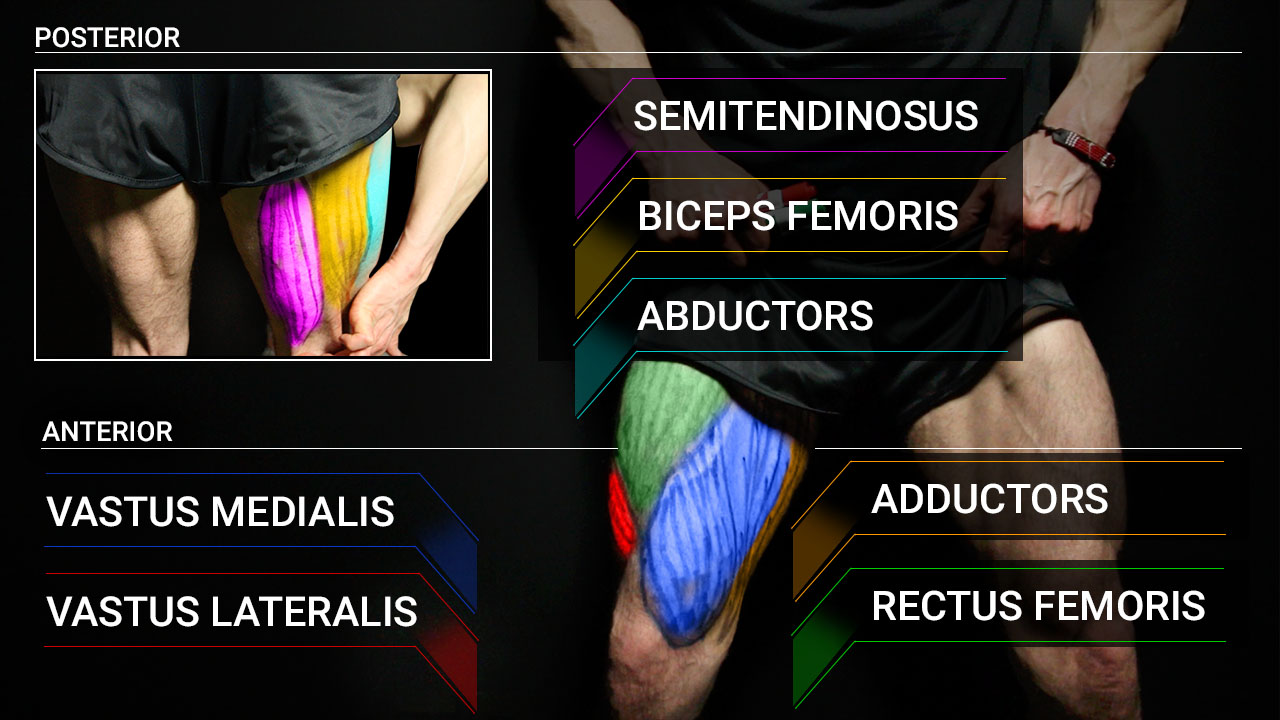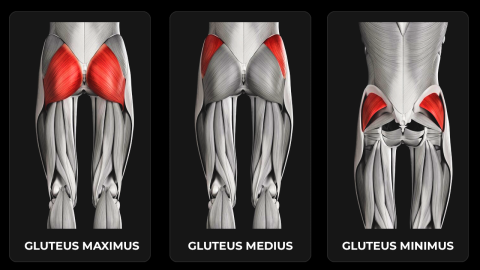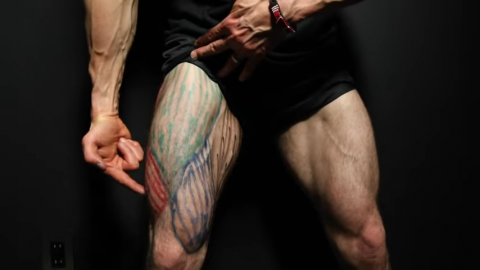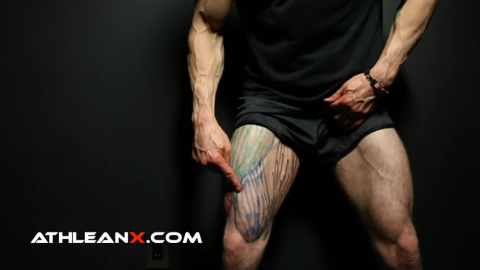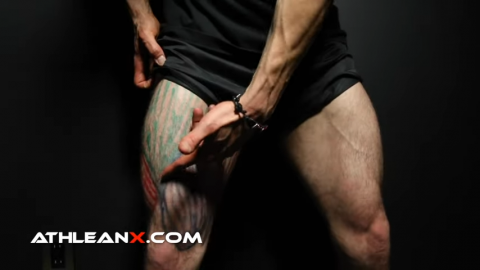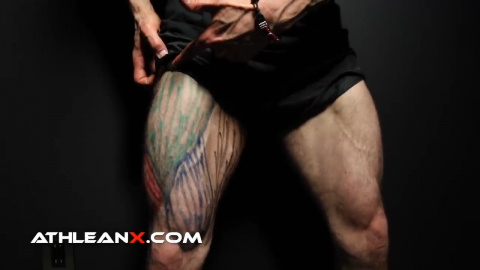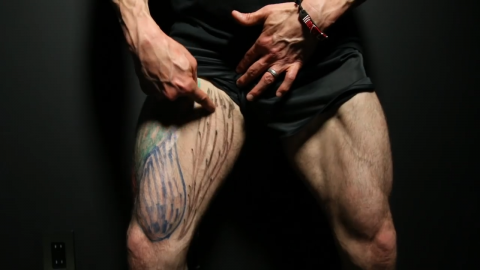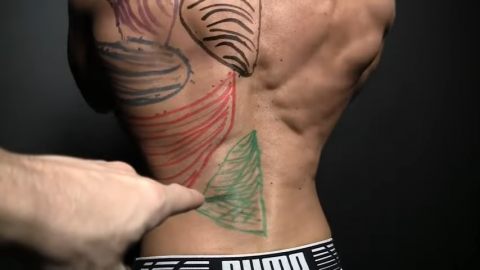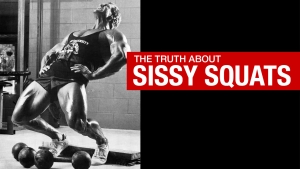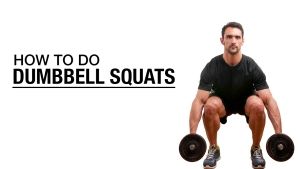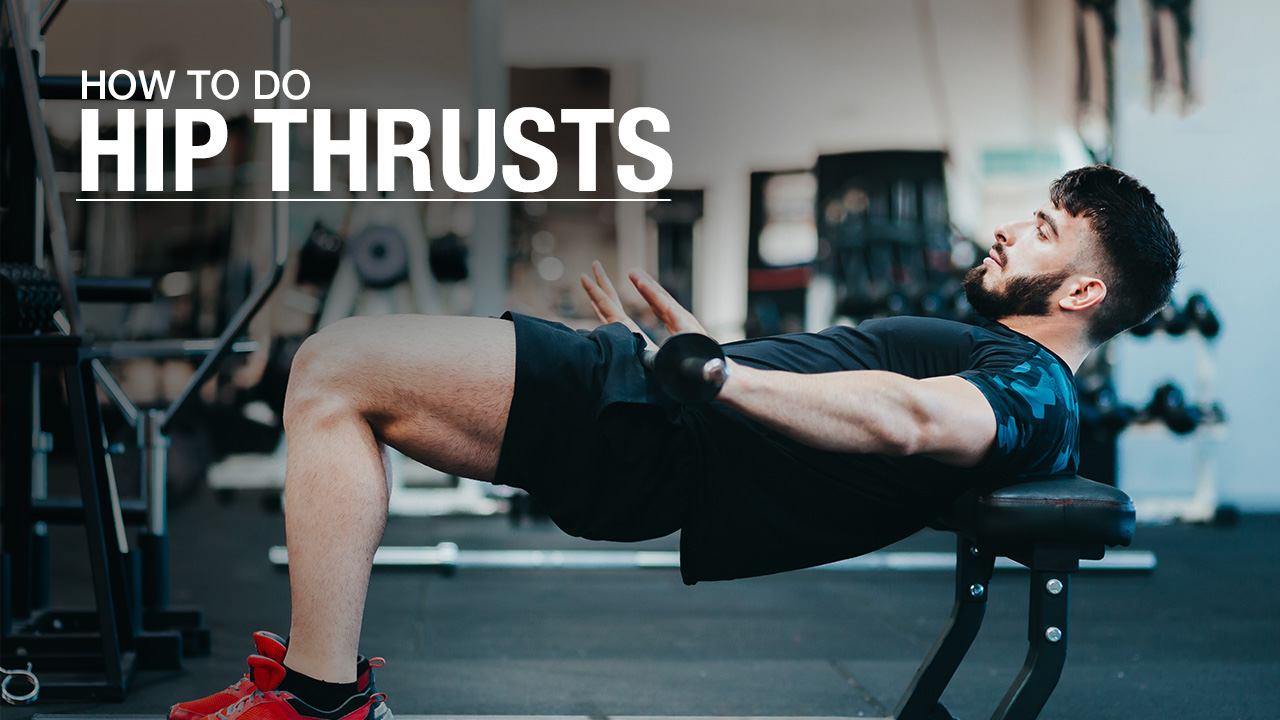
HOW TO PERFORM THE HIP THRUST CORRECTLY
Think Squats are the king of all lower body exercises? Think again.
If you’re overlooking Hip Thrusts, you’re missing out on a great all-in-one exercise for building powerhouse glutes and a strong lower body.
Today, I’m going to break down how to perform Hip Thrusts with perfect form, regardless of whether you’re using a dumbbell, barbell, or resistance band.
By the end, you’ll see why Hip Thrusts are an essential move for anyone serious about their lower body strength, development, and adding inches to their glutes.
To say goodbye to weak glutes, let’s dive in!
HIP THRUSTS: MUSCLES WORKED
Before you dive into Hip Thrusts, it’s a must to build a strong mind-to-muscle connection for your entire body.
Knowing exactly which muscles you’ll be targeting is essential for maximizing gains and ensuring proper technique.
Each step, angle, and level of resistance plays a role in sculpting powerful glutes and a stable core.
Over a period of time, understanding these key elements will elevate your exercise routines from basic to beast mode.
Here are the muscles that the standard barbell Hip Thrust trains:
GLUTES
When you hear “glutes,” most folks picture one big muscle back there.
But here’s the deal: it’s not just one muscle. It’s a trio working together.
You’ve got the gluteus maximus—the powerhouse. Then there’s the gluteus medius, the stabilizer, and the gluteus minimus, the underdog that’s key for hip stability.
Understanding these three is crucial for maximizing your glute gains and overall lower body strength.
GLUTEUS MAXIMUS
When it comes to Hip Thrusts, the gluteus maximus is your MVP for strong glutes.
This powerhouse muscle, the largest and most prominent of your glutes, starts from the upper hip and lower spine and attaches to the iliotibial tract and back of your thigh.
Its main job? Hip extension.
This is what powers you up from a squat, propels you up stairs, and drives your sprint.
During a Hip Thrust, the gluteus maximus is firing on all cylinders, pushing your hips upward and locking them out at the top.
It also helps with outward thigh rotation, adding stability to your hip joint.
Plus, it assists in thigh abduction, moving your thigh away from your body when your hip is flexed.
This muscle isn’t just about power; it’s about keeping you upright and supporting your lower back.
And let’s not forget, it stabilizes the sacroiliac joint, where your spine meets your pelvis.
In short, mastering the Hip Thrust means harnessing the full potential of your gluteus maximus for optimal strength and stability.
With that said, if you have tight hip flexors, you’ll want to spend some time stretching them out and using an activation exercise that focuses exclusively on the glutes beforehand.
For example, the bodyweight glute exercise, Glute Bridge is an effective exercise for tapping into that mind-to-muscle connection.
Once you loosen up the hip flexors and tap into the glutes, you can continue targeting them and waking them up with bodyweight Hip Thrusts.
GLUTEUS MEDIUS
Let’s talk about the gluteus medius, an essential player in your hip thrust workout.
This muscle originates from the outer surface of your hip bones and inserts on the greater trochanter of your femur.
While it’s not as famous as the gluteus maximus, it’s essential for achieving powerful glutes and maximizing your gains in glute exercises like Barbell Hip Thrusts and Single-Leg Hip Thrusts.
The gluteus medius is key for hip abduction, moving your thigh away from the body’s midline—critical for movements like walking, running, and squats.
During Hip Thrusts, this muscle works hard to keep your pelvis stable and aligned, especially when you’re lifting heavy weights or using the Hip Thrust machine.
It also assists in both medial and lateral rotation of the thigh, adapting to different foot positions and ensuring proper technique.
During a hip thrust, your gluteus medius helps maintain stability when you drive your hips upward, moving from the starting position to the extended position.
This stability is essential for effective glute bridges and other glute exercises.
The gluteus medius also supports your core and contributes to overall posture, making it a vital component of your posterior chain and hip extensors.
Incorporating variations like the classic Hip Thrust, Romanian Deadlift, and plyo box exercises into your training program can enhance glute strength and growth.
GLUTEUS MINIMUS
The gluteus minimus, though the smallest of the gluteal muscles, is an important player in your Hip Thrust workout.
This muscle originates from the lower portion of your hip bones and attaches to the front part of the greater trochanter.
When performing Hip Thrusts, whether with weight plates or on a Hip Thrust machine, the gluteus minimus ensures stability and precision in your movements.
Its primary function is hip abduction, which supports side-to-side movements and balance during exercises like Squats and Deadlifts.
During Hip Thrusts, especially Single-Leg Hip Thrusts, the gluteus minimus works hard to stabilize your pelvis, ensuring that your thrusts are effective.
The gluteus minimus also aids in medial rotation of the thigh when the hip is flexed, contributing to the proper technique and engagement of the hip extensors.
This muscle’s role in maintaining overall body posture and core stability is vital during Hip Thrusts and Glute Bridge exercises, helping you achieve the correct starting position, maintain a strong core throughout the movement, and reach the extended position with control.
HAMSTRINGS
Shift your focus to the back of your legs, and you’ll uncover the hamstring muscles.
These robust muscles are categorized into two primary groups:
BICEPS FEMORIS
Originating from the ischial tuberosity and femur, the biceps femoris plays a critical role in knee flexion, hip extension, and overall hamstring strength.
In the context of the Hip Thrust exercise, this muscle is essential for driving the hips upward from the flexed position to the extended position, working in tandem with the glutes to maximize thrust power and efficiency.
Properly activating your biceps femoris enhances your posterior chain strength and athletic performance.
When performing Hip Thrusts, the biceps femoris contributes significantly to the lift, supporting the glute muscles in creating a powerful posterior chain.
SEMITENDINOSUS
The semitendinosus, the other component of your hamstrings, plays a pivotal role in knee flexion and hip extension.
This muscle works in concert with the glute muscles to drive your hips upward from the flexed position to the extended position, contributing to the overall power and efficiency of the movement.
Stabilizing your pelvis, the semitendinosus enhances posterior chain strength and boosts athletic performance.
When performing Hip Thrusts, the semitendinosus ensures that your pelvis remains stable, allowing for proper form and effective engagement of the hip extensors.
By focusing on the semitendinosus, you enhance your ability to handle heavy weights and improve your Hip Thrust technique, contributing to more powerful glutes and a stronger posterior chain.
QUADRICEPS
Let’s dive into the powerhouse muscles of your legs: the quadriceps.
These aren’t just any muscles; these are the largest muscles in your legs, made up of four distinct heads.
When it comes to Hip Thrusts, your quads play an essential role in stabilizing your body and driving the movement.
VASTUS LATERALIS
The vastus lateralis significantly contributes to various squat variations and knee extension movements.
This muscle is not just crucial for your squats; it’s also a vital part of your Hip Thrust exercises.
During movements like the Classic Hip Thrust, the vastus lateralis helps stabilize your knees and maintain proper form, especially when you’re lifting heavy in Hip Thrusts.
This stability ensures that your hip extensors and glute muscles can fully engage, driving your hips from the starting position to the extended position with maximum power.
In exercises like Barbell Squats, Front Squats, and Goblet Squats, the vastus lateralis keeps your torso upright, an essential feature for reducing injury risk and improving your overall user experience.
Proper foot positions and angles are key to effectively engaging this muscle, which supports the hip bones and contributes to your posterior chain’s strength.
By integrating the vastus lateralis into your training program, you enhance your glute workouts with excellent activation exercises, including Hip Thrusts and Glute Bridges.
This muscle works in harmony with your core and upper body to handle external loads and improve your strength levels over a prolonged period.
VASTUS MEDIALIS
The vastus medialis, that inner front thigh muscle, is essential for knee extension and stability.
It fires up during deep squats like Barbell Front Squats and Bulgarian Split Squats, adding serious power to your lower-body workout.
When it comes to Hip Thrusts, the vastus medialis helps stabilize your knees, ensuring you maintain proper position and technique, especially with heavy weights.
This stability lets your glutes and hip extensors do their job effectively, driving your hips from the starting position to the extended position with power.
Strengthening this muscle reduces knee injury risk and boosts overall performance, making it a key player in your glute exercises and hip thrust program.
For athletes and fitness enthusiasts, focusing on the vastus medialis means stronger glutes and better results over time.
VASTUS INTERMEDIUS
The vastus intermedius helps with knee extension and maintaining posture during Squats.
During weighted Hip Thrusts, this muscle helps stabilize your legs, ensuring proper position and technique, especially under heavy loads.
This allows your glutes and hip extensors to fully engage and drive the movement from the starting position to the extended position.
RECTUS FEMORIS
The rectus femoris is unique among the quads because it attaches above the hip, giving it dual functionality.
It not only aids in knee extension but also facilitates hip flexion.
This makes it crucial for exercises involving both knee and hip movement, like High Knees and Leg Raises.
In Hip Thrusts, the rectus femoris stabilizes the hip crease and ensures proper operation throughout the movement.
Its dual role enhances your technique, helping you handle external loads effectively and contributing to glute growth over time.
This muscle is essential for maintaining proper form and boosting overall lower-body strength and mobility.
ADDUCTORS AND ABDUCTORS
When it comes to Hip Thrusts, don’t sleep on the adductors and abductors.
While they aren’t the prime movers in this exercise, they are active to a lesser extent.
These inner and outer thigh muscles stabilize your hips and maximize your thrust power.
Ignoring them means you’re missing out on some serious gains and proper form.
ADDUCTORS
Don’t overlook the adductors in your Hip Thrust routine.
Located on the inner thigh, these leg muscles are crucial for hip adduction and thigh rotation.
Properly training them prevents imbalances and reduces injury risk.
When you integrate adductor training, you enhance leg strength, stability, and mobility.
This not only boosts your hip thrust technique but also contributes to overall glute growth and functional movement.
Over time, focusing on the adductors ensures your leg exercises operate at optimal levels, handling external loads and extensions with ease.
ABDUCTORS
Your hip abductor muscles help move your legs outward and ensure stability during single-leg exercises like Hip Thrusts.
Neglecting them is a big mistake.
Strong abductors are vital for maintaining balance, enhancing athletic performance, and providing essential support during Hip Thrusts.
Over a long period of time, focusing on these muscles helps you handle resistance better and maintain proper form at 90-degree angles, ensuring your workouts hit all the essential features for maximum gains.
BACK
A strong back ensures your upper body stays aligned and supports the heavy load, maximizing the effectiveness of the thrust.
ERECTOR SPINAE (LOW BACK)
Think of your spine as the central pillar of your back strength, with the erector spinae muscles acting like strong, vertical supports.
These muscles, running from the base of your skull to your lower back, are crucial for maintaining proper posture and executing various movements.
During Hip Thrusts, an excellent exercise choice for the low back, the erector spinae play a key role in stabilizing your spine and keeping it in a neutral position.
This stability is essential for handling resistance and heavy loads, preventing injury, and ensuring effective muscle activation.
ABDOMINALS
Your abs deliver the stability and power you need to drive the Hip Thrust movement effectively.
RECTUS ABDOMINIS
The rectus abdominis, the largest muscle in your abdominal region, is what gives you that coveted six-pack.
This muscle spans the entire torso, from the top to the bottom, and is necessary for performing Hip Thrusts.
The rectus abdominis fibers run vertically, flexing the torso both when you curl up and lift your legs.
During Hip Thrusts, this muscle provides the essential stability and core strength needed to maintain proper form and handle resistance effectively.
Focusing on building strong abs over time helps you perform at your best and avoid injuries.
HOW TO DO HIP THRUSTS
Hip Thrusts provide several key benefits.
But one of the most important is their ability to neurologically activate the muscles that contribute to barbell strength exercises like the Barbell Squat, specifically the hamstrings and glutes.
This ensures they work together through combined flexion.
When performing a hip thrust, we engage both knee and hip flexion, effectively training the hamstrings and glutes to cooperate.
This is crucial because, in addition to knee flexion, the hamstrings also play a secondary role in driving hip extension along with the glutes.
This is the primary benefit of the Hip Thrust.
But it’s only possible to tap into this benefit if you perform the Hip Thrust correctly.
So, here’s a step-by-step breakdown of exactly how to perform the Hip Thrust with perfect form every time.
BARBELL HIP THRUST (ON THE FLOOR)

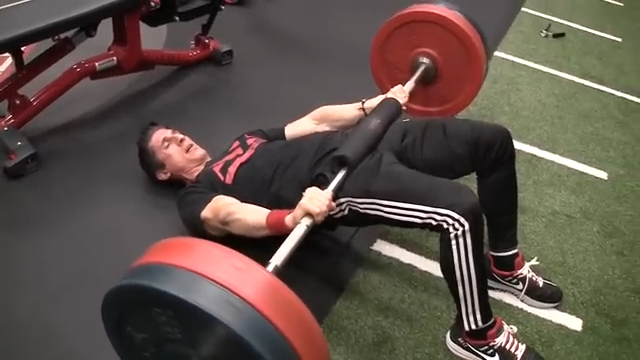
HOW TO DO THE BARBELL HIP THRUST (ON THE FLOOR):
- Sit on the floor with your legs bent and feet flat. Roll a barbell over your hips, using a pad to protect your pelvis. Your upper back and shoulders will stay on the ground for this variation.
- Place your feet shoulder-width apart, ensuring your knees are at 90-degree angles when your hips are lifted. This setup is essential for proper muscle activation.
- Tighten your core and push through your heels to raise your hips from the floor. Your knees, hips, and shoulders should form a straight line at the top. Squeeze your glutes for maximum contraction.
- Gradually descend your hips to the ground, keeping control and tension in your glutes and core throughout the movement. Avoid letting the barbell crash down.
- Repeat the movement for the desired number of reps. Start at basic levels with lighter weights and gradually increase the load over time as you build strength and confidence.
WHAT MAKES IT EFFECTIVE: Barbell Hip Thrusts are incredibly effective for the glutes because they maximize hip extension under heavy resistance, fully engaging and isolating the gluteal muscles for optimal growth and strength.
GLUTE MEDIUS HIP THRUSTS

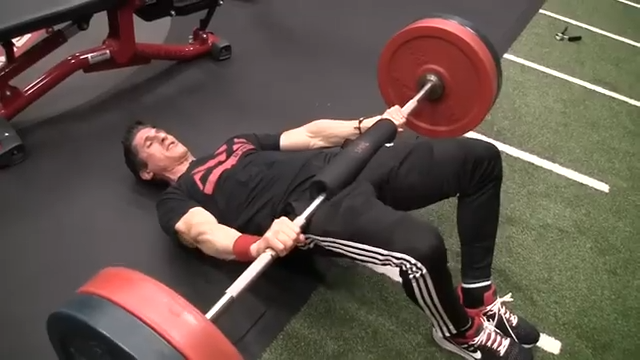
HOW TO DO THE GLUTE MEDIUS HIP THRUST:
- Sit on the floor with your legs bent and feet flat. Roll a barbell over your hips, using a pad for comfort. Your upper back and shoulders will stay on the ground for this variation.
- Bring your feet closer together than in a standard Hip Thrust and allow your knees to drop out to the sides. This external rotation of the hips engages the gluteus medius.
- Activate your core and push through your heels to elevate your hips from the ground. Your knees, hips, and shoulders should form a straight line at the top. Focus on squeezing your glutes, especially the gluteus medius, at the peak of the movement.
- Gently bring your hips back down to the floor, ensuring you maintain control and keep tension in your glutes and core. Avoid letting the barbell crash down.
- Repeat the movement for the desired number of reps, ensuring you maintain the external rotation of the hips throughout the exercise.
WHAT MAKES IT EFFECTIVE: This Hip Thrust variation incorporates external hip rotation by bringing your feet closer together and allowing your knees to drop out to the side. This positioning specifically activates the gluteus medius, a muscle that is often underutilized in standard lower body exercises.
BENCH BARBELL HIP THRUSTS

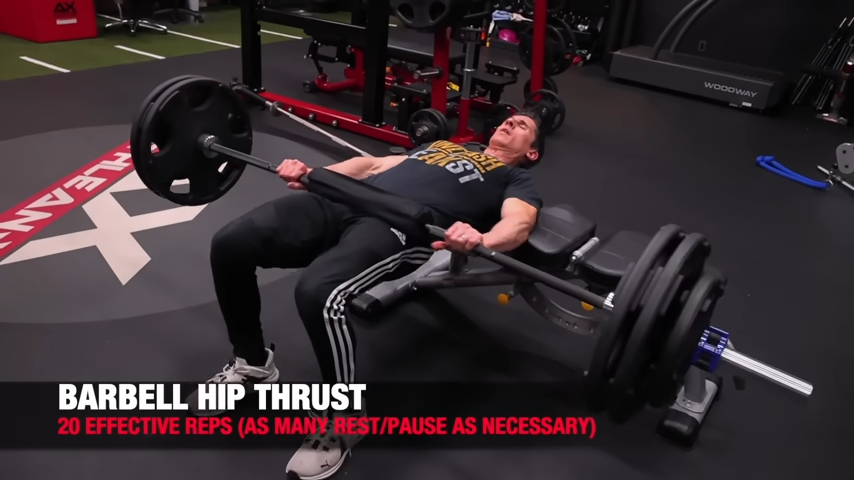
HOW TO DO THE BENCH BARBELL HIP THRUST:
- Try this advanced Hip Thrust variation:
- Position a bench horizontally and sit on the floor with your upper back resting against the bench to prepare for this double leg Hip T
- Roll a barbell over your hips, ensuring you have a pad for comfort to protect your pelvis.
- Place your feet flat on the ground, about shoulder-width apart. Adjust your feet so that your knees form a 90-degree angle when your hips are fully extended.
- Ensure the barbell is centered over your hips. Grip the barbell with both hands to keep it stable during the movement.
- Begin with your hips on the floor and your back resting on the bench. Engage your core and glutes to prepare for the lift.
- Drive through your heels and lift your hips toward the ceiling. Your upper back should pivot against the bench as your hips rise.
- At the peak of the lift, ensure your shoulders, hips, and knees align in a straight line. Contract your glutes forcefully at the top for maximum muscle engagement.
- Slowly lower your hips back to the starting position, maintaining control and tension in your glutes and core. Avoid letting the barbell crash down to the floor.
WHAT MAKES IT EFFECTIVE: As far as alternate exercises, this version maximizes glute activation by increasing the range of motion and allowing for a deeper stretch and stronger contraction. You can also perform this version on an exercise ball but be sure to use less weight.
HIP THRUSTS COMMON MISTAKES
Alright, let’s break down the common mistakes that can sabotage your Hip Thrust gains.
Avoid these mistakes, and you’ll see better results and avoid injuries while performing Hip Thrusts.
Master the technique and keep pushing for those powerful glutes!
NOT DRIVING THROUGH YOUR HEELS
Pushing through your toes instead of your heels shifts the focus away from your glutes and onto your quads.
Always drive through your heels.
This ensures maximum glute engagement and keeps the emphasis where it should be. You can even try lifting your toes slightly off the ground to reinforce this habit.
OVERARCHING THE LOWER BACK
Overarching your lower back at the top of the movement can lead to lumbar spine injuries and reduces the effectiveness of the exercise.
Keep your core tight and your spine neutral.
At the top of the movement, your body should form a straight line from your shoulders to your knees.
Avoid pushing your hips too high, which causes the lower back to arch excessively.
IMPROPER FOOT PLACEMENT
If your feet are too far forward or too close to your body, you won’t hit the right angles for optimal glute activation, leading to reduced effectiveness and potential knee strain.
Your knees should form a 90-degree angle when your hips are fully extended.
Adjust your foot position until you find the optimal placement where your shins are vertical at the top of the movement.
Experiment with different foot positions to see what feels most comfortable and effective for your glutes.
NEGLECTING CORE ENGAGEMENT
A slack core can compromise your form, leading to instability and increasing the risk of lower back injuries.
Engage your abs throughout the entire movement.
Think about pulling your belly button towards your spine to maintain a tight core.
This support will help keep your spine neutral and improve overall stability during the thrust.
USING TOO MUCH WEIGHT TOO SOON
Jumping straight to heavy weights can compromise your form, increase injury risk, and prevent you from effectively targeting the glutes.
Start with lighter weights to master the basic levels of the movement.
Focus on perfecting your form before gradually increasing the resistance over time.
This progressive overload will help you build strength safely and effectively.
NOT SQUEEZING AT THE TOP
Failing to squeeze your glutes at the peak of the movement means you’re not fully engaging the muscles, which limits muscle activation and growth.
At the top of each rep, pause and squeeze your glutes as hard as possible.
Hold this contraction for a brief count to ensure maximum muscle activation.
This extra effort at the peak will significantly enhance your glute strength and growth over time.
Remember, focus on perfecting your Hip Thrust form and technique in lieu of loading up the barbell.
Stay focused on your form, gradually increase the resistance, and don’t overlook the importance of engaging all the right muscles.
This will help you maximize those glute gains and prevent injuries.
If you’re looking for a training program that covers every muscle in the body, we’ve got you covered. Check out our ATHLEAN-X programs to see which is the best fit for your goals and fitness level.

- The Hip Thrust is an exceptional exercise for the glutes because it maximizes hip extension under heavy resistance, directly targeting and isolating the gluteal muscles for optimal growth and strength.
- Additionally, its unique range of motion and ability to load the glutes heavily make it superior to many other lower body exercises, leading to enhanced muscle activation and development.
- Here’s how to do the Barbell Hip Thrust:
- Sit on the floor with your knees bent and feet flat. Roll a barbell over your hips, using a pad for comfort. Your upper back and shoulders stay grounded for this version.
- Set your feet shoulder-width apart. Make sure your knees form 90-degree angles when you lift your hips. This setup is crucial for hitting the right muscles.
- Activate your core muscles and drive through your heels to lift your hips.
- At the top, your knees, hips, and shoulders should align in a straight line. Contract your glutes to achieve peak muscle activation.
- Slowly lower your hips back to the ground, maintaining control and tension in your glutes and core.
HIP THRUSTS FAQS
Hip Thrusts are a fantastic glute-building compound exercise. They isolate your glutes better than squats, giving you maximum glute activation and growth.
They focus the load directly on your glutes, ensuring they do most of the work, which is essential for building strong, powerful glutes.
Plus, Hip Thrusts reduce strain on your lower back and knees, making them a safer choice for many people, especially if you’re dealing with lower body injuries.
While Squats are great for overall leg development, Hip Thrusts are the go-to for targeting and sculpting your glutes with precision and safety.
Get on the floor with your knees bent and feet firmly planted. Position a barbell over your hips, adding a pad for extra comfort.
Position your feet hip-width apart. Ensure that your knees form a 90-degree angle when your hips are elevated.
Engage your core and press through your heels to elevate your hips.
At the top of the movement, your knees, hips, and shoulders should create a straight line. Squeeze your glutes to maximize muscle activation.
Gradually lower your hips back to the floor, keeping your glutes and core engaged throughout the movement to maintain control and tension.
Hip Thrusting is your ticket to building powerful, sculpted glutes.
This exercise isolates and maximizes glute activation better than almost any other movement.
It strengthens your posterior chain, improves hip extension, and enhances overall lower body strength.
Plus, it helps with athletic performance, from sprinting to jumping, by boosting explosive power.
If you want to lift heavier and move better, Hip Thrusts should be a staple in your routine.
REFERENCES

Jeff Cavaliere M.S.P.T, CSCS
Jeff Cavaliere is a Physical Therapist, Strength Coach and creator of the ATHLEAN-X Training Programs and ATHLEAN-Rx Supplements. He has a Masters in Physical Therapy (MSPT) and has worked as Head Physical Therapist for the New York Mets, as well as training many elite professional athletes in Major League Baseball, NFL, MMA and professional wrestling. His programs produce “next level” achievements in muscle size, strength and performance for professional athletes and anyone looking to build a muscular athletic physique.
















